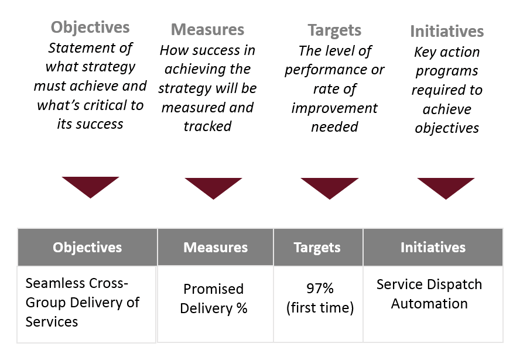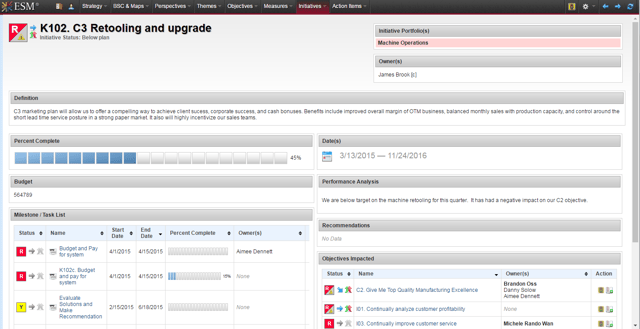What are the key characteristics of effective strategic initiatives?
For many organizations, the process of determining which initiatives are strategic and which are operational can be challenging. In order to clarify the differences between these two types of projects, it is critical that an organization go through a process of defining basic information for all ongoing and proposed initiatives. In this post, I’ll try to highlight some of the key markers of an effective strategic initiative.
Strategic Initiatives focus on change
The Balanced Scorecard can be broken down into four basic components: Perspectives, Objectives, Measures (also known as “KPIs” in some organizations), and Initiatives. Objectives state a clearly defined direction or outcome for an organization. An example of a Learning and Growth Objective might say something like, “Align Incentives and Rewards with Employee Roles for Increased Employee Satisfaction.”
While objectives tend to be broad, initiatives tend to more specifically outline how you are going to accomplish an objective. If an objective is where you are going, then the initiative is how you are going to get there.

This is where many organizations fall into the trap of confusing operations with strategy. Operations represent your day-to-day performance. Operations preserve value. Strategy is all about increasing value. Operational initiatives tend to be ongoing processes that remain fairly static.
Strategic initiatives, on the other hand, focus on change. A strategic initiative should add a new process or modify an existing process. A good initiative aligned to the example objective above might be, “Implement Cloud-based Performance Appraisal and Rewards System.” Notice how the initiative isn’t an existing process. It is a new project that the organization is going to embark on to align employee incentives and increase employee satisfaction. The logic behind how this initiative supports the objective may seem intuitive, but it should regardless be clearly expressed in the initiative definition.
Strategic Initiatives have a defined scope
Once a process has been stabilized, it becomes operationalized and can be removed from the scorecard. The concept of removing an initiative from a scorecard is important because it highlights another key characteristic of effective strategic initiatives: the scope.
The scope encompasses many aspects of the initiative such as clearly defined deliverables and outcomes, but it also touches on timelines. Each strategic initiative you create should include clear start and end dates. A strategic initiative’s duration can range from a couple of months to a couple of years. If the duration is less than a couple of months, then the scope is unlikely to be strategic. If the project is longer than a couple of years, then it is worth asking if one initiative might be more effectively broken down into two or three. By including dates, you put a stake in the ground related to providing a specific deliverable.
Including dates also has a profound impact on the conversation surrounding initiatives. Which resources do we need in order to accomplish this project on time? Is this a realistic estimate for accomplishing this goal?
Strategic initiatives with defined objective linkages, scopes, descriptions, dates, and deliverables are an excellent start to clearly understanding your strategic project. The full picture of the initiative is fleshed out by also incorporating key milestone/task dates. Milestones and tasks should outline the top 4-10 deadlines within the scope of an overall initiative. The number of milestones/tasks will largely depend on the size and complexity of your strategic initiative. A three month project managed by one person might only need a couple of high-level milestones. A two year strategic initiative that encompasses multiple teams and departments should be summarized into 8-10 milestones.
 Clearly defining your strategic initiatives with all of the suggested information is essential for the next steps in your strategy design, especially as you align initiatives with objectives, then prioritize initiatives based on need, resource restraints, etc.
Clearly defining your strategic initiatives with all of the suggested information is essential for the next steps in your strategy design, especially as you align initiatives with objectives, then prioritize initiatives based on need, resource restraints, etc.







